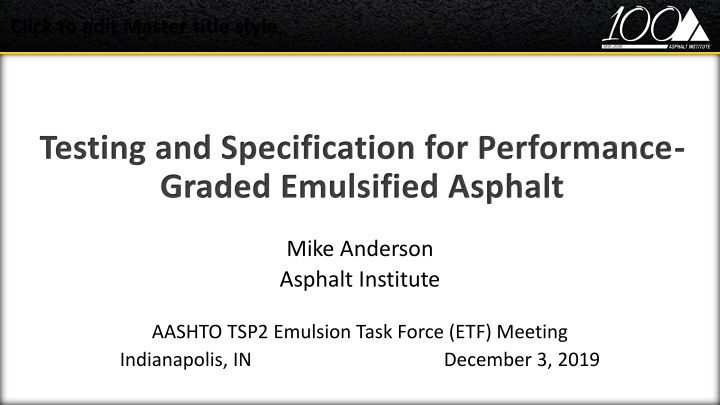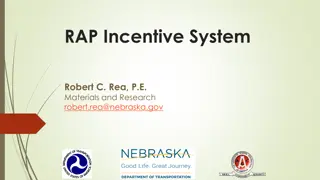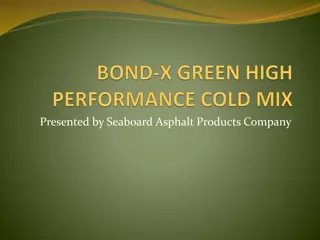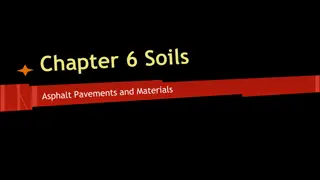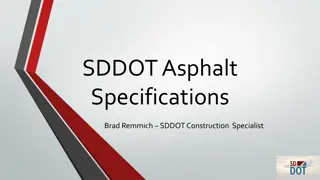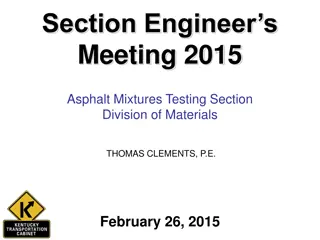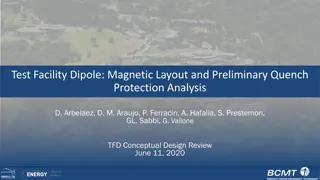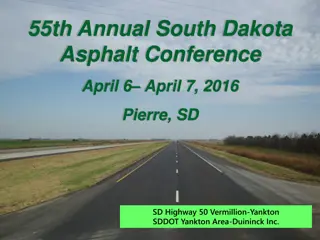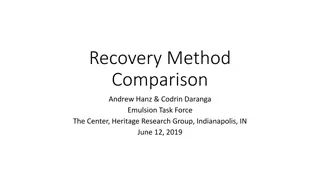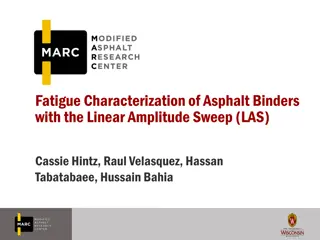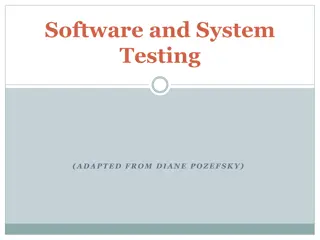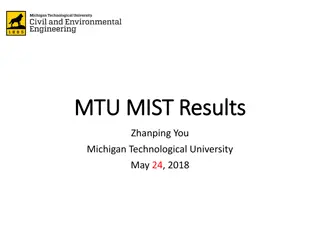Testing and Specification for Performance-Graded Emulsified Asphalt
This project focuses on developing a national performance-related material specification for emulsified asphalt binder for chip seals and microsurfacing/slurry seals. The objective is to create a specification that aligns with AASHTO Standard Specifications M320 and M332, utilizing readily available testing equipment while reflecting varying climatic and traffic conditions.
Download Presentation

Please find below an Image/Link to download the presentation.
The content on the website is provided AS IS for your information and personal use only. It may not be sold, licensed, or shared on other websites without obtaining consent from the author.If you encounter any issues during the download, it is possible that the publisher has removed the file from their server.
You are allowed to download the files provided on this website for personal or commercial use, subject to the condition that they are used lawfully. All files are the property of their respective owners.
The content on the website is provided AS IS for your information and personal use only. It may not be sold, licensed, or shared on other websites without obtaining consent from the author.
E N D
Presentation Transcript
Click to edit Master title style Testing and Specification for Performance- Graded Emulsified Asphalt Mike Anderson Asphalt Institute AASHTO TSP2 Emulsion Task Force (ETF) Meeting Indianapolis, IN December 3, 2019
Emulsified Asphalt Performance Grading (EPG) NCHRP 09-63 A Calibrated and Validated National Performance-Related Specification for Emulsified Asphalt Binder Project started May 1, 2019 Expected completion by May 1, 2023 Phase 1 Approximately 6 months Phase 2 Subject to approval by Project Panel Remaining 42 months
Project Objectives Develop a national performance-related material specification for emulsified asphalt binder for use with chip seals and microsurfacing/slurry seals that: a) is similar in concept and format to AASHTO Standard Specifications M320 and M332; b) is calibrated and validated with performance data from field test sections; c) uses readily available testing equipment (i.e., Superpave test equipment); and d) reflects varying climatic and traffic conditions.
Project Objectives Develop a national performance-related material specification for emulsified asphalt binder for use with chip seals and microsurfacing/slurry seals that: a) is similar in concept and format to AASHTO Standard Specifications M320 and M332; b) is calibrated and validated with performance data from field test sections; c) uses readily available testing equipment (i.e., Superpave test equipment); and d) reflects varying climatic and traffic conditions.
Developing the Draft ETF Specification ETF Testing Program in 2017-18 was instrumental in developing the draft specification The principal goals of the 2017 ETF Testing Program were to: Determine appropriate procedures to be used for high and low temperature rheological properties Determine the need for long-term aging Evaluate procedures intended to ensure the quality of polymer modification without excluding good performers
Residue Recovery Procedure AASHTO R78, Procedure B Recovering Residue from Emulsified Asphalt Using Low- Temperature Evaporative Techniques Thin film, silicone mat Forced draft oven at 60 C for 6 hours High and Intermediate temperature testing for performance grading
2017 ETF Testing Program High Temperature Testing on Recovered Residue EPG High Temperature Parameter (NCHRP 09-50, NC State) MSCR Jnr-3.2 values higher than typically seen for paving binders Likely caused by two factors Emulsion residue is most like original instead of RTFO-aged binder (factor of ~2 for Jnr) Grade temperature 3 C higher for surface treatments than paving asphalt mixtures (factor of ~1.25 for Jnr) As a result, unmodified emulsions generally fail May need to revisit criterion for Low traffic applications and/or change test parameters of MSCR procedure Use temperature that is uniformly lower than surface temperature by some amount (not ideal) Set criterion for Jnr at lower stress level (e.g., 0.1 kPa shear stress)
2017 ETF Testing Program High Temperature Testing on Recovered Residue SPG High Temperature Parameter (Texas A&M) G*/sin criterion generally was met, with some failures Variability between labs appeared higher than expected in some instances Could be a function of residue recovery procedure?
Draft ETF Specification High Temperature Parameter in Draft Specification Selected the SPG high temperature parameter (Texas A&M) G*/sin criterion appeared to provide adequate discrimination Variability known to be lower than variability from MSCR test, irrespective of any variability due to the residue recovery procedure Continue to evaluate MSCR Jnr as possible high temperature parameter Some agencies have already transitioned to AASHTO M332 for paving grade asphalt binders; more expected in the future
2017 ETF Testing Program Intermediate/Low Temperature Testing on Recovered Residue EPG Low Temperature Parameter (NCHRP 09-50, NC State) Tested on as-recovered residue Criteria based on maximum allowable G* at critical phase angle ( c), based on low temperature grade Temperature-frequency sweep test DSR using 8-mm parallel-plate geometry, following draft research procedure Two temperatures (5, 15 C) 0.1-100 rad/s, logarithmically spaced with 10 loading frequencies per decade Mastercurve generated at Tref=15 C to determine G* at c
2017 ETF Testing Program Intermediate/Low Temperature Testing on Recovered Residue SPG Low Temperature Parameter (Texas A&M) Tested on recovered residue subjected to further PAV aging Criteria based on maximum allowable BBR Stiffness at 8 seconds loading at low temperature grade
Draft ETF Specification Low Temperature Parameter in Draft Specification Selected the EPG low temperature parameter (NC State) BBR testing resulted in similar low temperature grade for all recovered residue More residue required for BBR than DSR Added step of PAV aging G* at c DSR test Less residue needed for 8-mm parallel plate geometry than BBR Showed some discrimination between different residues Rational response with temperature changes Not without some challenges
Draft ETF Specification Polymer Presence in Draft Specification Uses maximum phase angle requirement at Tc,high Tc,high = temperature where G*/sin = 0.65 kPa From Texas A&M research Concerns comparing values for SBR-modified residues compared to SBS-modified residues Not a true performance-based parameter Use as an EPG-Plus test? Similar to manner in which user agencies ensure polymer modification for paving asphalt binders
Residue Recovery Procedure What was learned from the 2017 ETF Testing Program? Time from residue recovery to testing appears to matter in measured test values How was that lesson applied to the 2018 ETF Testing Program? The following guidance was provided to labs: Before recovering the asphalt emulsion, please ensure that the test procedures will be conducted on the recovered residue within 48 hours after recovery.
Residue Recovery Procedures (2018 Program) AASHTO R78, Procedure B Recovering Residue from Emulsified Asphalt Using Low- Temperature Evaporative Techniques AASHTO T59, Section 7 Emulsified Asphalt Residue by Evaporation Forced draft oven at 163 C for 3 hours Modified asphalt emulsions only Intended to put SBR and SBS modified residues on more even field for comparison High temperature testing for polymer identification Added to 2018 ETF Testing Program based on analysis from 2017 data
2018 ETF Testing Program High Temperature Testing on Recovered Residue Determination of G*/sin Testing Details Perform in accordance with AASHTO T315 25-mm parallel plate geometry, 1-mm gap, 12% shear strain Temperature sweep starting at 55 C and proceeding in 6 C increments until failure (the point where G*/sin is less than 0.65 kPa) Report G*/sin at each temperature at each temperature Tc,high the continuous high temperature grade where G*/sin = 0.65 kPa at Tc,high the value of phase angle at the continuous high temperature grade
2018 ETF Testing Program High Temperature Testing on Recovered Residue Determination of MSCR Parameters Testing Details Perform in accordance with AASHTO T350 25-mm parallel plate geometry, 1-mm gap Test temperature at 3 C higher than LTPPBind Grade Temperature (as indicated with sample) and at 3 C lower than LTPPBind Grade Temperature Corresponds to surface PG and 6 C lower than surface PG, respectively Use a new test specimen for each temperature Report Jnr0.1 and Jnr3.2 at each temperature R0.1 and R3.2 at each temperature
2018 ETF Testing Program Intermediate-Low Temperature Testing on Recovered Residue Determination of G* at critical phase angle ( c), reported as Gc Testing Details Perform in accordance with Research Draft Standard 8-mm parallel plate geometry, 2-mm gap, 1% shear strain Frequency sweep at each temperature starting at 0.1 rad/s and proceeding to 10 rad/s using 10 loading frequencies per decade. Three temperatures starting at 25 C, then proceeding to 15 C, and finally 5 C Report G* and at each temperature and frequency Gc at critical phase angle (based on surface low temperature grade)
Isotherms 1.0E+05 1.0E+04 1.0E+03 G*, kPa 25 1.0E+02 15 5 1.0E+01 1.0E+00 1.0E-01 1.0E+00 1.0E+01 1.0E+02 Frequency, rad/s
Shifted Data 1.0E+09 1.0E+08 1.0E+07 1.0E+06 |G*| (Pa) 1.0E+05 1.0E+04 90 1.0E+03 80 1.0E+02 70 Shifted Data 1.0E+01 60 Phase Angle () Model 1.0E+00 50 1.0E-06 1.0E-04 1.0E-02 Reduced Frequency (rad/s) 1.0E+00 1.0E+02 1.0E+04 1.0E+06 40 30 20 Shifted Data Model 10 0 1.0E-06 1.0E-04 1.0E-02 Reduced Frequency (rad/s) 1.0E+00 1.0E+02 1.0E+04 1.0E+06
Shifted Data Black Space 1.0E+09 1.0E+08 1.0E+07 1.0E+06 G*. Pa 1.0E+05 1.0E+04 1.0E+03 1.0E+02 20 30 40 50 , degrees 60 70 80 90
Shifted Data Black Space 1.0E+09 1.0E+08 1.0E+07 1.0E+06 G*. Pa 1.0E+05 1.0E+04 1.0E+03 1.0E+02 20 30 40 50 , degrees 60 70 80 90
Black Space Effect of Aging 1E+09 1E+07 G*, Pa 1E+05 1E+03 0 45 90 Phase Angle, degrees
Black Space Effect of Aging 1.0E+09 1.0E+08 1.0E+07 1.0E+06 G*. Pa 1.0E+05 1.0E+04 1.0E+03 1.0E+02 20 30 40 50 , degrees 60 70 80 90
2018 ETF Testing Program Some Key Takeaways from the Analysis Consistency in residue recovery is important to minimize variability AASHTO R78, Procedure B has higher variability particularly for high temperature results AASHTO T59, Section 7 mitigates some of the variability, but changes the values
AASHTO re:source PSP PSP Year PSP Identification Material G*/sin @ 58 C, kPa Average 1s 1s% d2s d2s% Number of Labs G*/sin @ 64 C, kPa Average 1s 1s% d2s d2s% Number of Labs 2014 2015 2016 EML 61-62 CSS-1 EML 63-64 SS-1h EML 65-66 CQS-1h 1.748 0.360 20.6% 1.019 58.3% 8.115 3.343 41.2% 9.461 116.6% 4.777 1.475 30.9% 4.174 87.4% 29 26 32 0.825 0.161 19.5% 0.456 55.2% 3.673 1.393 37.9% 3.942 107.3% 2.233 0.812 36.4% 2.298 102.9% 29 26 32
AASHTO re:source PSP G*/sin
2018 ETF Testing Program Some Key Takeaways from the Analysis Phase angle limits for polymer identification generally separate modified from unmodified emulsion residues using AASHTO R78 Procedure B recovery 84-degree maximum generally segregates unmodified from modified residue AASHTO T59, Section 7 recovery appears to make all modified residues more easily pass the criterion Generally greater effect on latex-modified (SBR) residue than polymer-modified (SBS) residue
2018 ETF Testing Program Some Key Takeaways from the Analysis Intermediate temperature properties appear to be strongly impacted by low temperature grade The lower the low temperature grade, the higher the G* at c regardless of whether the residue is unmodified or modified Function of the base asphalt binder? May see changes once formulations change to meet new specification
2018 ETF Testing Program Some Key Takeaways from the Analysis MSCR limits suggested by NCHRP 09-50 may need to be re- evaluated A G*/sin value of 0.65 kPa is comparable to a Jnr-3.2 value of approximately 17.6 kPa-1 Twice as high as the limit for low traffic from NCHRP 09-50 research How much will change when formulations change to adapt to new specification?
2018 ETF Testing Program AASHTO R78, Procedure B 100.00 Jnr-3.2 at 61C, kPa-1 10.00 Lab 1 Lab 2 Lab 3 1.00 Lab 4 Lab 5 0.10 0.10 1.00 10.00 G*/sin at 61C, kPa
2018 ETF Testing Program Some Key Takeaways from the Analysis MSCR Jnr,3.2 variability still high Not helped by variability in recovery procedure Testing at temperature of EPG-6 appears more appropriate for discrimination of results R0.1 at temperature of EPG-6 appears appropriate for discrimination of results Average of CRS-2 residue = Average of CRS-2L residue = Average of CRS-2P residue = 4% 42% 57%
NCHRP 09-63 Activities Phase 2 Conduct Experimental Plan Propose Final Specification Communicate Findings through Presentations Provide Final Report
NCHRP 09-63 Field Experiments NCAT/MnROAD Partnership Low Traffic CSAH-8 (near Pease, Minnesota) reported as 700 vehicles per day Lee Road 159 (Auburn, Alabama) reported as 1,200 vehicles per day with 60% trucks High Traffic US-169 (near Pease, Minnesota) reported as 16,000 vehicles per day US-280 (near Opelika, Alabama) reported as 17,000 vehicles per day with 16% trucks.
NCHRP 09-63 Field Experiments New/Existing Chip Seal and Microsurfacing/Slurry Seal Projects Identify a minimum of 16 projects in the four environmental regions (Wet-Freeze, Wet-No Freeze, Dry-Freeze, and Dry-No Freeze) Laboratory testing will be performed on the asphalt emulsion using the draft specification developed in Phase I. Follow-up observations in subsequent years
NCHRP 09-63 Field Projects Lab Testing on Emulsion Residue low temperature evaporation to produce emulsion residue; high temperature testing at appropriate surface temperatures to determine G*/sin (AASHTO T315); high temperature testing at appropriate surface temperatures and stress to determine Jnr (AASHTO T350); evaluation of the phase angle at the temperature where G*/sin = 0.65 kPa; evaluation of MSCR Recovery at appropriate temperature and stress (for polymer modified emulsion residue); and intermediate temperature testing to assess the low temperature properties of the emulsion residue using temperature-frequency sweep testing on the DSR to determine G* at c
NCHRP 09-63 Field Projects Follow-up evaluation of projects condition of the surface treatment micro-sampling, extraction/recovery of the emulsion residue, and testing conditions in service can be better correlated with the properties of the in-situ emulsion residue.
95th AAPT Annual Meeting and Technical Sessions The 2020 Annual Meeting will be held March 22-25, 2020 Westin San Diego Gaslamp Quarter, San Diego, California USA Our 2020 venue 2020 Annual Meeting The Annual Business Meeting and Technical Sessions of the Association of Asphalt Paving Technologists (AAPT) will be March 22-25, 2020 in San Diego, California at Westin San Diego Gaslamp Quarter. The annual meeting includes asphalt-related technical sessions comprised of peer-reviewed papers, and invited presentations on specific topics in the AAPT-ISAP International Forum, and Symposium as well as a Student Poster Session. Westin San Diego Gaslamp Quarter Visit http://asphalttechnology.org/annual-meeting.html for more details as they become available. Important dates December 2019 Annual Meeting registration opens March 22-25, 2020 - Annual Business Meeting and Technical Sessions AAPT Office: 6776 Lake Drive, Suite 215 Lino Lakes, MN 55014 Phone: 651-293-9188 Email: aapt@asphalttechnology.org For the latest information please check our web site at: http://www.asphalttechnology.org
http://asphalttechnology.org/membership.html Become an AAPT Member! Have access to a wealth of information and emerging technologies including free webinars Be an integral part of a technical community comprised of individuals from all parts of the asphalt industry (material suppliers, researchers, agency owners, consultants, and equipment manufacturers) Enjoy the camaraderie of colleagues in the field during annual meetings at attractive venues Be a part of lively debates on important technical issues Belong to a North American-based organization with significant international membership and focus Be a member of an association that operates without organizational biases; policies set by and for individual members by an elected Board Support the next generation of asphalt technologists through a robust student scholarship program
NCHRP 09-63 Questions or Comments? Mike Anderson Principal Investigator Asphalt Institute manderson@asphaltinstitute.org 859-288-4984 Adriana Vargas Lead Research Engineer National Center for Asphalt Technology vargaad@auburn.edu 334-844-7303
